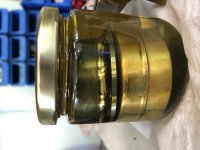Healey Nut
Luke Skywalker
Offline
So my BJ8’s have the brass floats .
Fired up the 64 today to go for a drive , distinct smell of fuel , fuel pouring from front carb overflow .
Checked and cleaned the shut off needle valves but noticed the front float wasnt sitting as high in the fuel and didnt bob up and down as well as the rear . Fished it out with two slim screwdrivers and sure enough it full of fuel .
no obvious cracks or fuel leaking from it .
I have it sitting on a paper towel and no wet patches .
maybe if I heat it a little with a hair dryer to increase the pressure in it the fuel will be forced out ?
Fired up the 64 today to go for a drive , distinct smell of fuel , fuel pouring from front carb overflow .
Checked and cleaned the shut off needle valves but noticed the front float wasnt sitting as high in the fuel and didnt bob up and down as well as the rear . Fished it out with two slim screwdrivers and sure enough it full of fuel .
no obvious cracks or fuel leaking from it .
I have it sitting on a paper towel and no wet patches .
maybe if I heat it a little with a hair dryer to increase the pressure in it the fuel will be forced out ?

 Hi Guest!
Hi Guest!

 smilie in place of the real @
smilie in place of the real @
 Pretty Please - add it to our Events forum(s) and add to the calendar! >>
Pretty Please - add it to our Events forum(s) and add to the calendar! >> 


